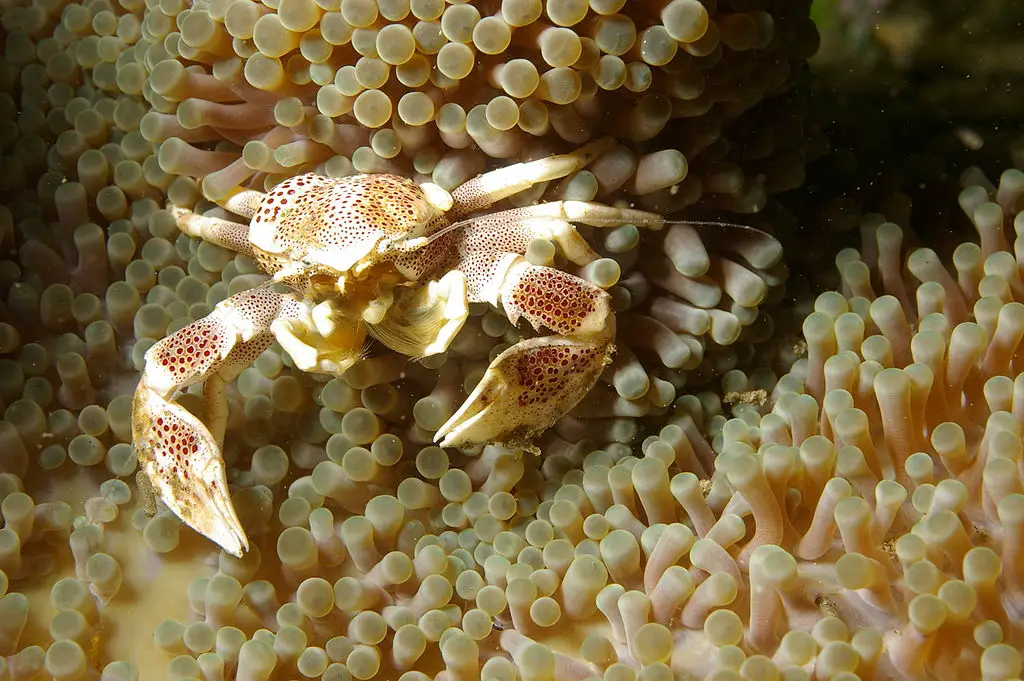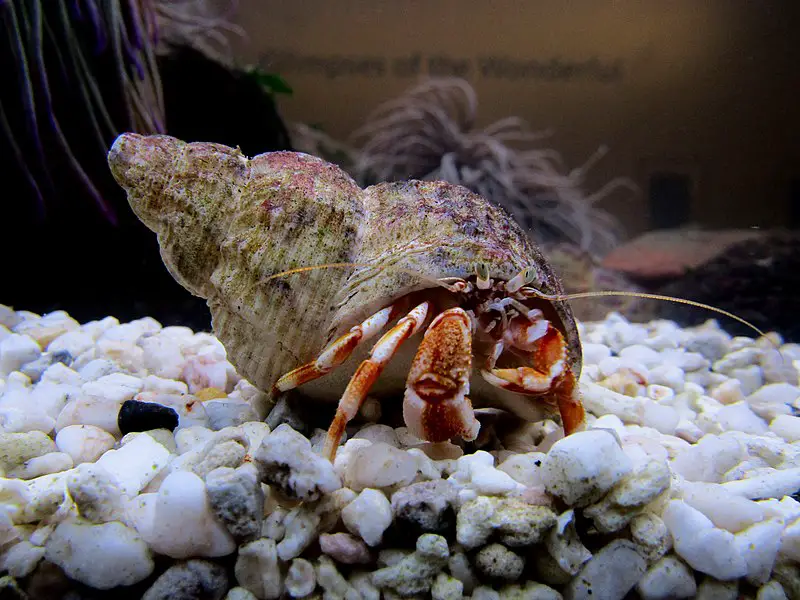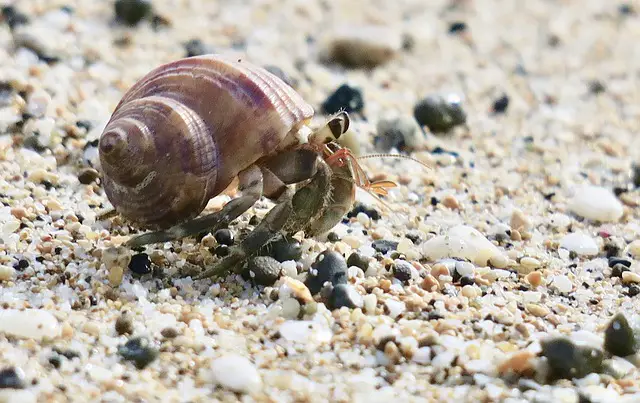Porcelain crabs are small, intriguing creatures that many aquarists consider adding to their reef aquariums. These crustaceans are known for their unique appearance and delicate nature, leaving hobbyists curious about their compatibility with reef tanks and other tank inhabitants. The question posed by many marine enthusiasts is whether porcelain crabs are, in fact, reef safe.
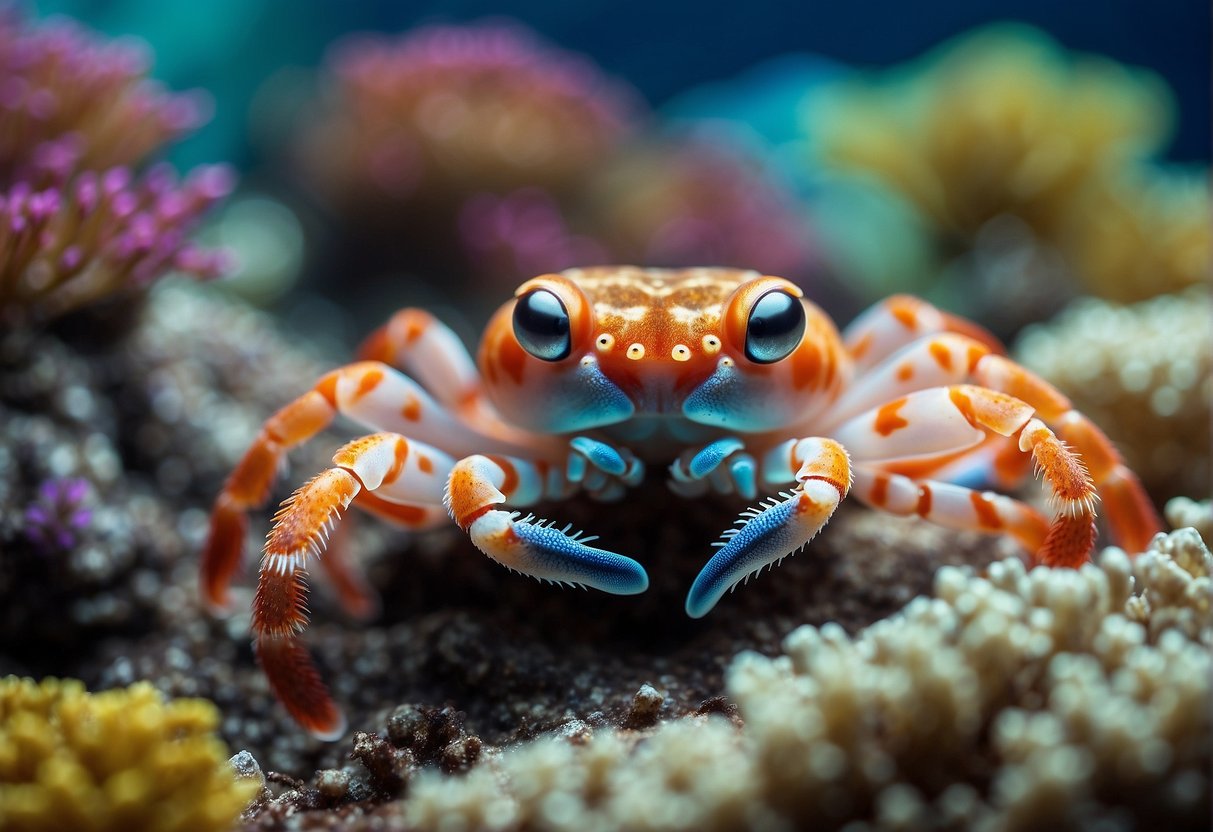
In the world of reef aquariums, “reef safe” refers to species that coexist harmoniously with coral and other invertebrates without causing damage or disturbance. Porcelain crabs fit this description and are often regarded as a beneficial addition to a reef ecosystem. They are filter feeders, scavenging for larger meaty portions, and actively cleansing the water.
Native to tropical and subtropical shallow subtidal waters, porcelain crabs are commonly found in rocky and coral reefs, making them well-suited for a reef tank environment. Their peaceful nature and the benefits they provide to the tank make them a popular choice for aquarists aiming to create a diverse and harmonious marine ecosystem.
Porcelain Crab Overview
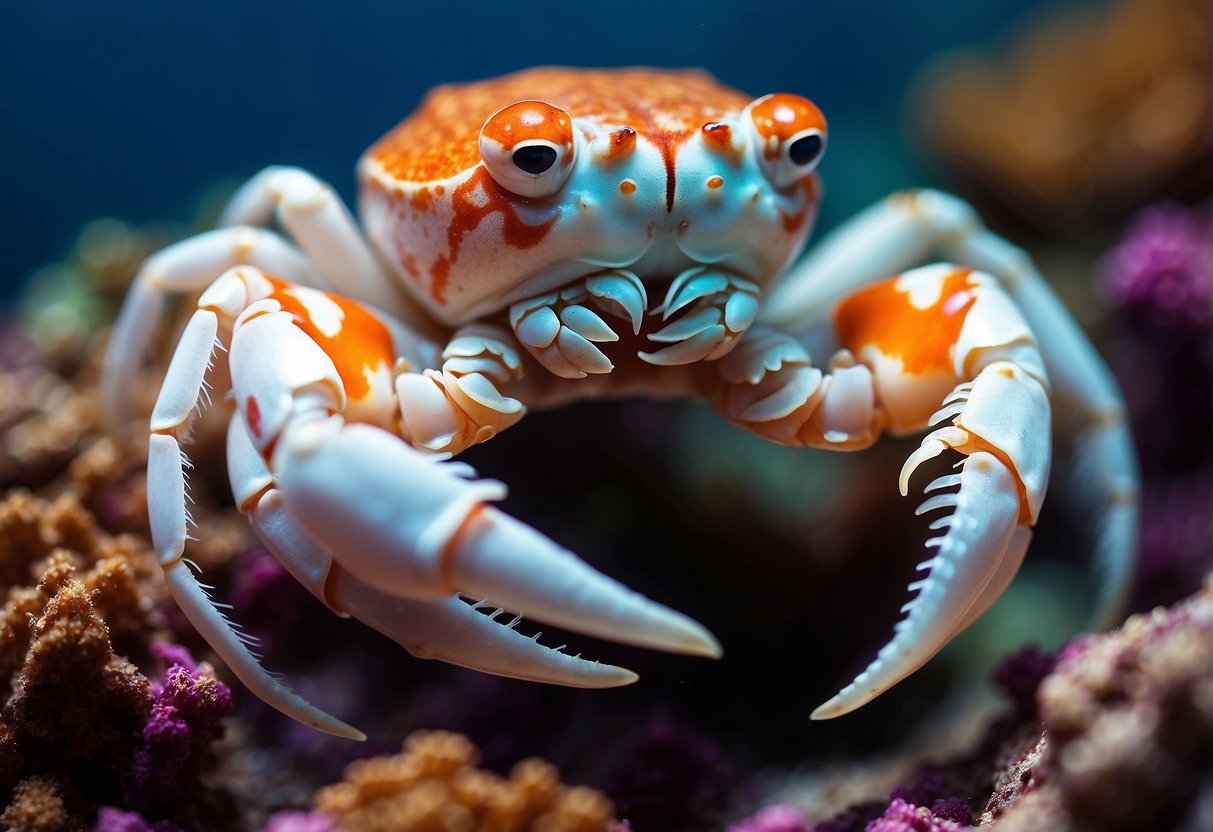
Taxonomy and Classification
Porcelain crabs belong to the family Porcellanidae within the infraorder Anomura. They are crustaceans characterized by their flattened bodies, making them well-adapted to their aquatic environment. Their unique morphology and taxonomy set them apart from other crab species.
Physical Characteristics
The porcelain crab’s body width usually does not exceed 15 millimeters, making them relatively small compared to other crab species. This small size allows them to thrive in reef tanks without requiring ample space or resources, thus making them ideal tank mates for various aquatic inhabitants (Reef Tank Addict).
The physical attributes of porcelain crabs contribute to their ability to coexist with other marine life. They possess large front claws and huge pincers, although they primarily utilize these for territorial disputes within their species rather than aggression toward other tank inhabitants (Youtube).
Moreover, a typical adult Porcelain Anemone crab has a leg span of about 6 to 8 centimeters (2.4 to 3 inches) across, with a carapace length ranging from 2.5 to 3 centimeters (1 inch) (Aquarium Breeder).
Habitat and Distribution
Natural Habitat
Porcelain crabs are usually associated with various types of corals in the tropical oceans. Their small, flattened bodies, measuring around 15 millimeters in width, allow them to thrive in the crevices and spaces between corals or rocks in their natural habitat. They also live alongside anemones in symbiotic relationships, utilizing these marine invertebrates for protection from predators1.
Their body structure is highly adapted to turbulent water conditions, having a compressed shape for better stability2. This characteristic allows them to stay comfortably in areas with strong currents and water movement, making them versatile and adaptable to different reef environments.
Geographical Range
Porcelain crabs inhabit a vast geographical range in the Pacific Ocean, particularly in temperate and tropical zones of the Indo-Pacific region3. Their widespread distribution indicates their ability to thrive in diverse reef environments and under changing water conditions. This adaptability makes them suitable candidates for home reef aquariums, especially considering they do not require a lot of space or resources to thrive.
In the context of a reef tank, porcelain crabs make excellent tankmates due to their small size and non-aggressive nature1. They are known to be reef-safe, meaning they do not threaten corals or other inhabitants of the tank4. Moreover, they contribute to tank cleanliness as they are filter feeders and scavengers5, consuming debris and waste within the aquarium.
Reef Compatibility
Associations with Corals and Anemones
Porcelain crabs are reef safe and can form symbiotic relationships with certain corals and anemones in a reef tank. The most common association is with anemones, where the porcelain crab shares a mutual benefit with its host. The crab gains protection from potential predators, while the anemone benefits from the crab’s feeding activities, which helps to keep the anemone clean and oxygenated.
These crabs are also known to interact with clownfish, often found living with anemones. In some cases, the porcelain crab, clownfish, and anemone develop a triangular symbiotic relationship, where all three species benefit.
Behavior with Other Reef Inhabitants
Porcelain crabs are generally peaceful and pose minimal threat to other reef tank inhabitants. They are not predatory; their large claws are mainly used for self-defense and maintaining their position on the reef. Regarding diet, their primary food source consists of planktonic materials, which they filter out of the water column using specialized appendages called setae.
Some key aspects of porcelain crab behavior include:
- Shy and reclusive nature
- Coexist peacefully with other reef safe crabs
- Non-aggressive towards fish and invertebrates
Feeding and Nutrition
Dietary Needs
Porcelain crabs are primarily filter feeders, meaning they rely on planktonic food such as zooplankton and phytoplankton for their sustenance. They also consume meaty food, such as frozen shrimp and mussels, and vegetable matter like seaweed sheets1.
In addition to their filter-feeding habits, porcelain crabs have been known to scavenge for food particles within their environment, allowing them to take advantage of a wide range of nutritional sources.
To provide an optimal diet for your porcelain crab, offer a mix of the following:
- Planktonic food: Zooplankton and phytoplankton
- Meaty food: Frozen shrimp, mussels, and marine pellets3
- Vegetable matter: Seaweed sheets
Feeding Mechanism
The feeding process of porcelain crabs is quite fascinating. Utilizing specialized appendages known as maxillipeds, these crabs use a fan-like motion to capture plankton and other suspended food particles in the water column4.
They then transfer the captured food directly into their mouth, filtering each morsel through a fine mucus before ingesting it. This feeding mechanism allows porcelain crabs to efficiently gather essential nutrients from their environment while expending minimal energy.
When caring for porcelain crabs in an aquarium, observing their feeding behavior closely is important. It is not uncommon for them to fan the water at odd times, which may signal hunger4. Consistently monitoring their behavior and offering a diverse range of food items in appropriate proportions will ensure a happy, healthy porcelain crab.
Aquarium Care
Tank Requirements
Porcelain crabs are delicate and fascinating creatures that make a great addition to a reef tank. When setting up an aquarium, they must consider their natural habitat to provide the appropriate conditions. These crabs are commonly found in rocky and coral reefs of temperate and tropical coasts, so replicating such an environment is recommended1.
A minimum tank size of 20 gallons should ensure enough space for movement and prevent territorial issues. Ensure that an adequate amount of live rock and caves is included, as porcelain crabs like hiding and seeking refuge in crevices. Moreover, they have a symbiotic relationship with anemones, which provide shelter and protection from predators2.
Water Quality and Parameters
Maintaining optimal water quality and parameters is crucial to keeping porcelain crabs healthy and thriving in your marine aquarium. The ideal temperature for these invertebrates is between 72-78°F3. Maintaining a consistent temperature to reduce stress for the crab is essential.
As for other water parameters, keep dKH levels between 8 and 12 and maintain a pH range of 8.1 to 8.43. The ideal salinity levels should be between 1.023-and 1.025 specific gravity3. Regularly testing the water and adjusting any imbalances is necessary to create a stable environment for your porcelain crab.
Reproduction and Lifespan
Breeding Behavior
Porcelain crabs are known for their unique breeding patterns. They reproduce in pairs, with a male and female forming a strong bond.
During mating, females can be observed with new broods immediately post-molt and several days following their molt, suggesting that mating occurs for females in intermolt and post-molt states3. In laboratory experiments, the median time between broods was 6 days, ranging from 2-to 22 days.
Growth and Development
The growth and development of porcelain crabs start from the larval stage and continue until they reach their adult size. As they mature, porcelain crabs undergo several molting stages, shedding their exoskeleton to accommodate their growing body.
Fully grown porcelain crabs have a leg span of about 6-8 cm (approximately 2.4 – 3 inches), while their carapace length usually ranges from 2.5 to 3 cm (about 1 inch)5. The body shape of porcelain crabs is compressed, which is advantageous for maintaining a stable position in turbulent water5.
Though the exact lifespan of porcelain crabs in the wild is unknown, they tend to have a relatively longer life span when compared to other crab species. They have been known to live in a controlled environment such as a reef aquarium for several years, provided the water conditions and habitat are well-maintained1.
Interactions with Other Species
Compatibility with Fish and Invertebrates
Porcelain crabs are generally considered reef-safe and compatible with various fish, shrimp, and invertebrates. Their docile nature allows them to coexist peacefully with most other species in the tank.
Fish Compatibility: Most fish species can share the tank with porcelain crabs without causing problems. Examples include clownfish, which often share the same anemones as the porcelain crabs, and other reef-safe fish species.
Shrimp Compatibility: Porcelain crabs can also coexist with different types of shrimp, including cleaner shrimp and fire shrimp, as they do not compete for the same resources. The crabs and the shrimp help maintain a clean environment within the reef tank.
Invertebrate Compatibility: In the reef ecosystem, porcelain crabs are considered scavengers, feeding on algae, leftover food, and small particles. This makes them compatible with other invertebrates like snails, hermit crabs, and starfish.
Potential Threats
Despite their generally peaceful nature, there are still a few potential threats to porcelain crabs in a reef tank that one should be aware of:
- Predators: Some fish species may see porcelain crabs as prey. Larger, aggressive fish, like groupers and eels, should be avoided in a tank with porcelain crabs.
- Territorial Disputes: While porcelain crabs are often docile, they may occasionally engage in non-fatal territorial disputes with other porcelain crabs or fish, such as clownfish. These altercations are typically over space within an anemone.
- Emerald Crabs: Although they are invertebrates, emerald crabs can threaten porcelain crabs. Emerald crabs are known for their aggressive behavior and may compete with porcelain crabs for food or space within the tank, potentially leading to a confrontation.
Conservation and Threats
Environmental Impact
Porcelain crabs play a key role in maintaining a healthy reef ecosystem. They are known for their scavenging abilities, helping to keep the reef clean by feeding on detritus and occasionally consuming algae. In addition to scavenging, porcelain crabs are also filter feeders, contributing to the reef’s overall water quality and health.
Although porcelain crabs have a minimal impact on coral, there is always the potential for some indirect effects. For example, if a crab gets into a territorial dispute with other reef inhabitants, this could potentially lead to damage to nearby corals.
Species Conservation Status
The conservation status of porcelain crabs is not well-documented, but it is essential to understand the potential risks to their population. Factors such as habitat loss, pollution, and climate change may threaten porcelain crab populations by impacting the overall health of the reef ecosystem. These threats are not unique to porcelain crabs, as many organisms within the reef face similar challenges.
One example of a potential issue is coral bleaching. Coral bleaching occurs when coral loses its symbiotic algae (zooxanthellae) due to stress, resulting in the loss of its color and its primary food source. This can lead to coral death, which, in turn, jeopardizes the home of organisms like porcelain crabs and disrupts the delicate balance that exists within the reef ecosystem.
Footnotes
- Everything You Need to Know About Porcelain Crabs – Reef Tank Addict ↩ ↩2 ↩3 ↩4 ↩5
- Porcelain Anemone Crab – Detailed Guide: Care, Diet, and Breeding ↩ ↩2
- Porcelain Anemone Crab | Care & Info – Maryland Aquarium Design ↩ ↩2 ↩3 ↩4 ↩5 ↩6 ↩7
- Porcelain crab really reef safe? – Reef Central Online Community ↩ ↩2 ↩3
- Advice/Tips on caring for Porcelain Crab | REEF2REEF Saltwater and Reef ↩ ↩2 ↩3

